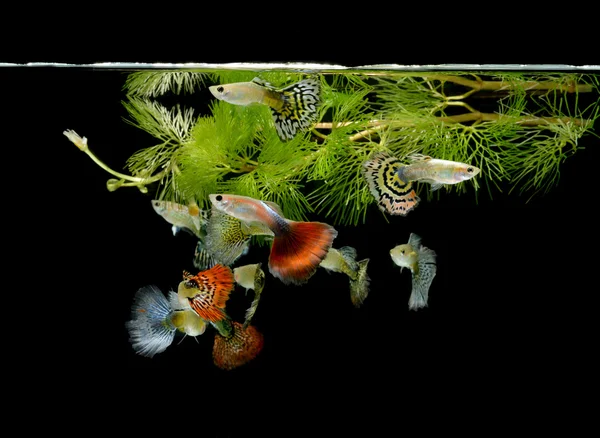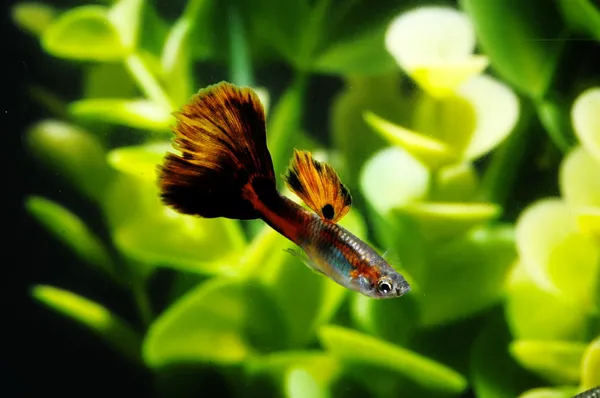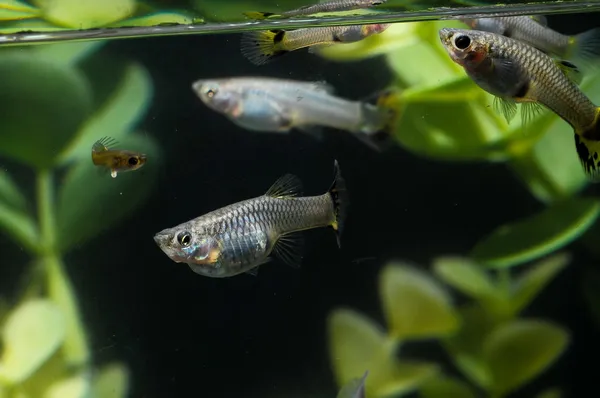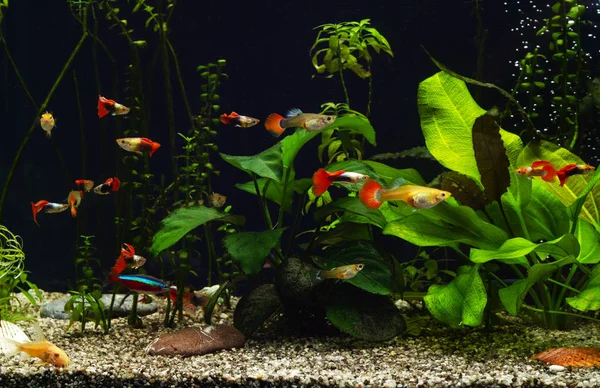Guppies are popular aquarium fish for many reasons. They are very hardy and easy to care for, eat just about anything, are beautifully colored, and are super easy to breed! In fact, guppies are the first aquarium fish for millions of people around the world.
Of course, in order to breed guppies, you need to be able to tell the difference between the sexes. Is it difficult to do, as it is in many other animals? How to tell if a guppy is male or female?
How to Tell the Difference between Male and Female Guppies
Male guppy fish are the ones that draw the most attention from fish keepers when browsing the pet store. Guppy fish are strongly sexually dimorphic, which means that you can tell the difference between male and female guppies just by looking at them.

Not all fish are sexually dimorphic. For some, such as freshwater Angelfish, it is almost impossible to identify male and female fish just by looking at them. Likely the fish can tell by subtle differences in behavior, hormones released, and even colors beyond our ability to see. Even a professional breeder will have trouble sexing these kinds of fish.
But the gender difference in male and female guppies apart is about as easy as it gets for freshwater aquarium fish!
Characteristics of Male Guppies
| Characteristics | Male Guppy |
| Dorsal/Tail Fin Shape | Fancy, long fins (depending on breed) |
| Anal Fin Shape | Pointed anal fin; gonopodium |
| Behavior | Chasing away males and moving towards females |
| Length | 1 to 1-1.5 inches |
| Colors | Bright and vibrant |
Here are the characteristics of male guppies:
- Vibrant color formation in body and fins
- Long, flowing dorsal fin and tail fin (depending on breed)
- Guppy’s body shape is elongated and thin
- Pointed anal fin
One quick way to identify male and female guppies is to look at the colors. Male guppies are always more brightly colored than females. This bright coloring is an advertisement for their sexual fitness as partners.
Female guppies will sometimes have brightly colored tails. But they never have intense bodily coloration as male guppies do.
The body shape male guppies have is noticeably slimmer than that of a female’s body. Males are both smaller and thinner than female guppies of the same age.
What is the Gonopodium in Male Guppies?
Another very reliable method for identifying a male guppy is to look at the anal fins of the fish. Male guppies have a pointed, tube-like anal fin when they reach sexual maturity. This is a special organ called the gonopodium. All guppy fry and immature guppy fish have a triangular anal fin. But once they are mature, the anal fin of the males’ rolls on itself.

The gonopodium of male guppies is analogous to the penis in male mammals. Since guppy fish are livebearers, the male has to impregnate female guppies internally. So the gonopodium delivers sperm directly into the female guppy fish.
When he is trying to fertilize a female, you will see male guppies rotating the gonopodium forwards to reach her belly. So if you see a pointed anal fin in a small guppy with bright coloring, then you know you are looking at a male!
Characteristics of Female Guppies
| Characteristics | Female Guppy |
| Dorsal/Tail Fin Shape | Usually rounded (depending on breed) |
| Anal Fin Shape | Triangular fan-shaped fin |
| Behavior | Peaceful |
| Length | 2 inches or more |
| Colors | Subdued (except for tail fin) |
And here are the characteristics of female guppies:
- Brightly colored tails but few bright colors on body
- Usually larger and chunkier
- Dark spot located above anal fin along the belly
- Rarely have flowing tail fin or dorsal fins
Female guppies are very distinctive from just about any male guppies you see. For starters, a female guppy is always going to be less brightly colored than male guppies. A female guppy is not competing for attention for males. Pretty much every male will be interested in her, so she has little need for attention-grabbing colors.
As with males, another reliable indicator for sex is to study the guppy’s anal fin. Female guppies have an anal fin shaped like a triangular fan. It’s a normal-looking fish fin and has no purpose except to help a female guppy fish swim and stabilize itself in the water.
A female guppy’s body is also a little hefty at all times. Even if she is not pregnant with guppy fry, female guppies are always a bit chunkier because she has extra room in her body cavity for holding ovaries and fry.
Just so you have some visual guidance on this subject, here is a comprehensive video on sexing male and female guppy fish!
What is the Gravid Spot in Female Guppies?
A final easy way to tell the difference between male and female guppy fish is to look for a dark gravid spot. The gravid spot is a dark patch of color that forms on the belly of a female guppy when she is pregnant with guppy babies.

Not all females grow a gravid spot, though. It depends on the individual fish, how heavily pregnant she is, and the pigment of her skin. Pregnant female guppies with dark skin colors might not display a gravid spot. And a female with only a few guppy babies might have a faint gravid spot or none at all.
But if you see a gravid spot, then you are definitely looking at a female guppy. The gravid spot is actually the wall of the ovary pressing against the translucent internal skin of the female’s body. The darkness comes from the eyes of the female guppy fry developing and waiting to be born into the world!
Behavioral Differences Between Male and Female Guppies
Now that we’ve discussed the physical differences between male and female guppy fish let’s look at some differences in behavior as well!
Male Guppy Behavior
Males and females are very different in how they relate to one another. Even a brief glance at an aquarium full of guppies will allow you to see the difference!
Male guppies spend most of their time chasing females and chasing other males around. They want to mate with females and prevent other males from mating with them. Male guppies don’t form territories or harems like more social fish do. Male cichlids are much more proactive in controlling access to females.
Usually, male guppies will only rarely fight. And when they do, it is mostly for display since they don’t have teeth and can’t really hurt each other.

It is a good idea when keeping guppies to have more females than males; I recommend two female guppies per male guppy. This way, no one female is being harassed constantly by males ready to mate. Remember, males and females are always around each other in a fish tank.
Since females have nowhere to hide in an aquarium, they can become stressed if they are surrounded by aggressive, overeager males constantly looking to breed with them.
Female Guppy Behavior
A female guppy tends to be more relaxed in how it relates to other guppies. Female guppies don’t spend much time chasing each other or males. They may turn on and snap at a bothersome male, but usually, they just swim away if they are feeling annoyed. Both snapping at and running from a male guppy rarely deters him for long, though!

How Can I Determine the Sex of Guppy Fry?
When raising guppy fry, you might be tempted to try and separate out the male guppy babies from the female guppy fry. Unfortunately, telling male or female guppy fry apart isn’t possible. They are still sexually immature and haven’t developed the characteristics of adult male or female guppies.
It takes roughly two months (8 weeks) for you to be able to sex male and female guppy fry. The anal fin of the little fish that are males will roll up into a gonopodium. And depending on the breed, you may see longer dorsal fins and long caudal fins (tail fin).
The females will take on a thicker body shape, but their shorter dorsal fins and shorter caudal fins are unmistakable.
Once this happens, you should start looking for homes for the live fry as they will shortly begin breeding with each other. A young female can begin giving birth shortly after reaching maturity. Even if she or her partner is not fully grown.
Can a Female Guppy Have Fry Without a Male?
Even if you can determine the sex of a guppy and separate them from one another…Sometimes female guppies mysteriously give birth. Even if they have been kept alone for many weeks, a female might suddenly become pregnant. Do these fish reproduce asexually somehow?

Guppies need to reproduce sexually so the female does not impregnate herself. But female guppies do have a remarkable ability to store sperm. Just because a female mates does not mean that baby guppies are right around the corner.
The guppy’s body can store sperm for weeks, allowing her to find better living conditions, wait for better mates, and otherwise put off pregnancy. If your female guppy fish was living alongside males at the pet store, then this is likely what happened and why she is only now pregnant!
What to Do If a Female Guppy Is Pregnant?
Once you have a pregnant female guppy, you have to decide if you want to spend extra time raising the guppy fry. If so, then it is a good idea to separate her into a breeding trap. These devices are plastic cages that sit inside of the fish tank (often hanging on the side of the glass).
Breeder traps allow water to flow from your filter and heater and are a lot less expensive than buying a separate aquarium. You can wait for a female guppy to give birth and then return her to the main aquarium.
Once she does so, the baby guppies will remain in the breeder trap, where you can feed them baby brine shrimp, crushed flakes, and other appropriately sized food. Eventually, they will grow large enough that you can then keep them alongside their parents in the main aquarium!
Wrapping Up

Sexing guppies is very easy to do with just a few minutes of your attention. The colors, anal fin, tail fin, guppy’s body, and behavior all offer clues to whether you have a male or female guppy in front of you. Sexing baby guppies is impossible. But adult fish are very easy to both keep and breed!
Interesting Related Reading:
- What Are Female Fish Called?
- What Are Ideal Water Temperatures for Guppies?
- Can Guppies and Angelfish Live Peacefully?
- Can Guppies Live in Ponds?

